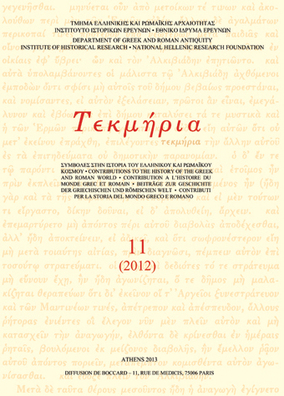Επιτύμβιες επιγραφές από τη συλλογή του Μουσείου Βυζαντινού Πολιτισμού
Part of : Τεκμήρια ; Vol.9, 2008, pages 169-208
Issue:
Pages:
169-208
Section Title:
Articles
Author:
Abstract:
Ten funerary inscriptions are examined in this article. They are dated between the 2th-3th and the 5th-6th c. AD and originate from the two cemeteries in Thessaloniki, the eastern and the western. Only one of them is accurately dated in 470 AD, as it mentions the office of hypatus and more specifically Flavius Iordanes who was the hypatus of Constantinople in 470 AD. Two of the inscriptions have decorations. The first one (cat. n. 5) has a carved pattern of two hands with opened palms which is probably a gesture of praying and can be often found, like in this case, in children's funerary plaques. The second (cat. n. 6) is decorated with the image of Aphrodite «von fréjus» in relief. This particular inscription is added to the wellknown group of funerary reliefs with mortals in the iconographie type of a god. All the inscriptions are in Greek, and there is evidence of the use of local idioms (disoumon) or spelling mistakes due to the phenomenon of iotacism. As far as the burial customs are concerned it is confirmed the habit to bury more than one people in the same grave (cat. n. 8), to reuse a funerary plaque in another grave (cat. n. 2a, b) or even as a construction material (cat. n. 8). The texts refer to family relations such as between husbands and wives, parents, children, brothers and threptoi. The names presented in the inscriptions are Greek, Greek versions of Latin originals (Proklos, Roufos, Sekoundos, Sekoundilla, Tiberis) or Greek versions of Hebraw originals (Iordanes, Maria) and can be grouped together according to their meaning. Therefore, there are names which express physical or moral qualities (Argyris, Glauka), the wishes, the hopes or the opinions that parents have for their children (Eutychianos, Polychronios) as well as names related to the war and its wishful outcome (Nikiforos, Niki, Nikiani). There are also names of the gods (Dionis, Hermes) which confirm, once more, their spread especially in the popular social strata. Some of the names in the inscriptions are rare (Argyris, Dionis, Pasagathi) but some other are rather very common (Epafrodeitos, Hermes, Zoelos, Paramonos). Conclusively the people mentioned in the inscriptions considered were simple inhabitants of Thessaloniki, unknown to us from other sources and they didn't occupy a title or an honorable position during their lifetime.
Subject:
Subject (LC):




